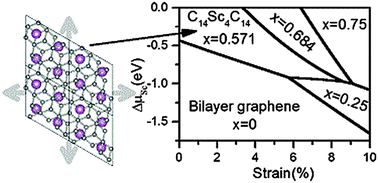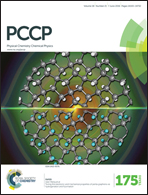High-coverage stable structures of 3d transition metal intercalated bilayer graphene†
Abstract
Alkali-metal intercalated graphite and graphene have been intensively studied for decades, where alkali-metal atoms are found to form ordered structures at the hollow sites of hexagonal carbon rings. Using first-principles calculations, we have predicted various stable structures of high-coverage 3d transition metal (TM) intercalated bilayer graphene (BLG) stabilized by the strain. Specifically, with reference to the bulk metal, Sc and Ti can form stable TM-intercalated BLG without strain, while the stabilization of Fe, Co, and Ni intercalated BLG requires the biaxial strain of over 7%. Under the biaxial strain ranging from 0% to 10%, there are four ordered sandwich structures for Sc with the coverage of 0.25, 0.571, 0.684, and 0.75, in which the Sc atoms are all distributed homogenously instead of locating at the hollow sites. According to the phase diagram, a homogenous configuration of C8Ti3C8 with the coverage of 0.75 and another inhomogeneous structure with the coverage of 0.692 were found. The electronic and magnetic properties as a function of strain were also analyzed to indicate that the strain was important for the stabilities of the high-coverage TM-intercalated BLG.


 Please wait while we load your content...
Please wait while we load your content...